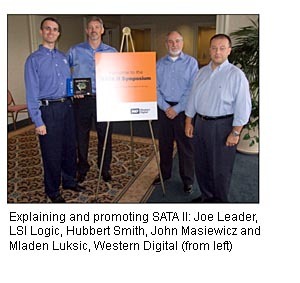Western Digital and LSI Logic explain and promote SATA II harddrives
Newport Beach (CA) - Disk drive maker Western Digital Corp (Lake Forest, California) and disk controller chip and adapter manufacturer LSI Logic Corp (Norcross, Georgia) have taken to the road to help system builders and resellers transition to the latest hard disk standard, Serial Advanced Technology Attachment II or SATA II. While marketing is always a goal of such efforts, the two companies are placing a heavy emphasis on technical information in their presentations.
At one recent event in Newport Beach, California, Western Digital's Mladen Luksic noted that an industry organization, the "SATA-International Organization" or "SATA-IO" (www.sata-io.org), is developing a set of SATA II specifications. These will include a minimum feature set and testing procedures a SATA II drive must meet to comply with the organization's requirements. SATA-IO has not yet released its SATA II specifications, but disk controller and drive manufacturers are already incorporating some of them in shipping products.
Masiewicz pointed out that disk manufacturers are likely to offer products that do not include all of these features. However, they will build drives with specific combinations of features, customizing them for different applications from high reliability enterprise RAID systems to low power laptop drives.
The SATA I standard has already been approved by the American National Standards Institute and is now before the International Standards Organization. The ISO is expected to approve the standard without change. SATA-IO has not yet decided whether to bring its finalized SATA II specifications to the two standards organizations. But, as Masiewicz noted, ANSI and ISO standards do not and cannot compel compliance. Even adherence to the SATA-IO specifications is voluntary. To carry the SATA II label under the SATA-IO specification, a drive will only have to have been tested using specific testing methodologies. Also, because SATA I drives can be used with SATA II controllers, a SATA I drive can be labeled "SATA II Compatible" without even meeting the testing methodology specification.
Western Digital and LSI Logic are delivering SATA II products that implement the SATA II standard including support for such features as 3Gbps transfer rates and intelligent data access queuing.
Get Tom's Hardware's best news and in-depth reviews, straight to your inbox.
